Seventeen London Group artists reflect on how their practice has been affected by the experience of lockdown.
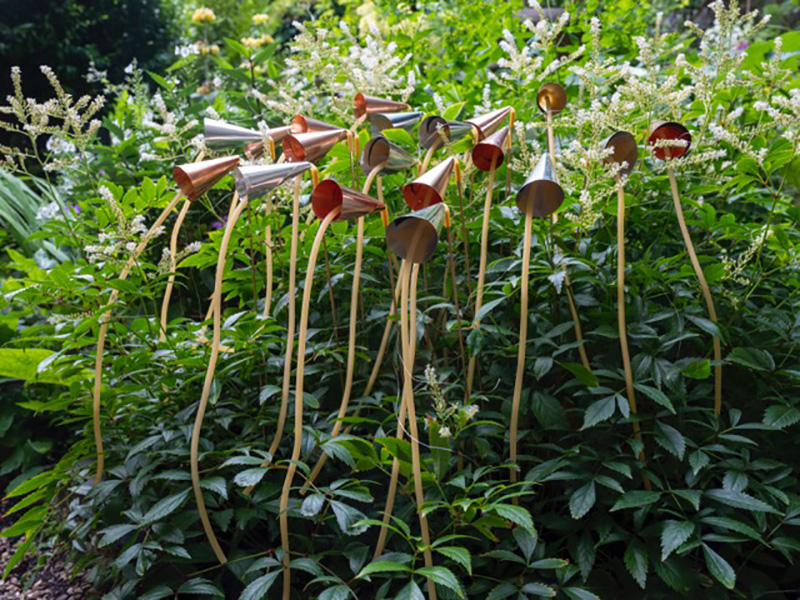
Listening to Insects
At first nothing at all. Total blank, no concentration, no focus. After a while a sense of urgency returned. On a small scale making began, using materials already available. I spent long periods of time sitting outside and focusing on the minutiae of the garden. Crucial to remain calm, listening to surrounding ambient sounds, slowing right down with only the immediate limited view important; everything further afield a distant memory.
I became aware of the amazing amount of insect activity, the buzzing myriad of wings invading my head. No positive or negative, just how it is to spend a moment in time transforming this into something tangible. Now it is blank again, the cycle waiting to repeat itself.
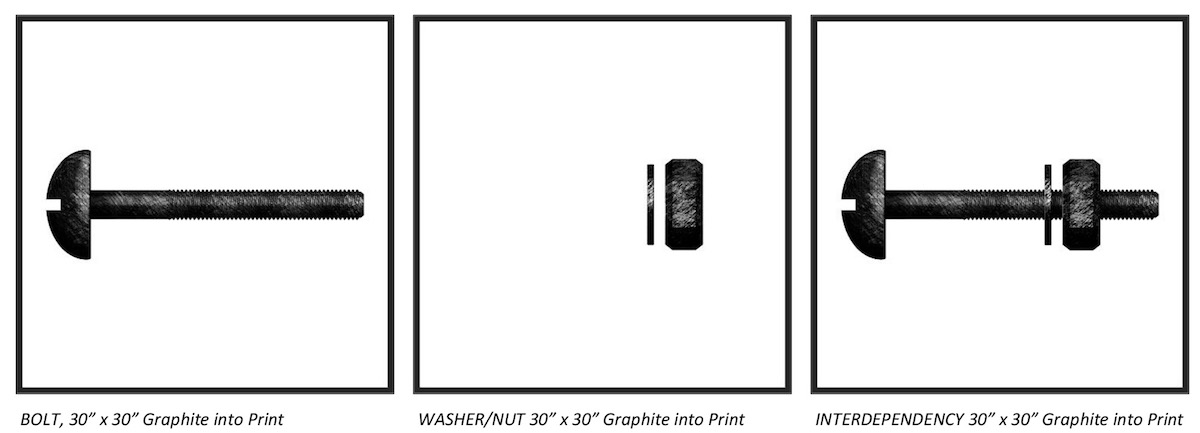
My drawings have for the past thirty years explored the ambivalent nature of our experience of reality, commenting on time past in relation to time present and anticipating time future. They reference natural form and order and our accountability as makers/manipulators within the world and call attention to the principles of balance – that we should be mindful of the fragility and irrevocability of biological balance, our dependency on this balance and the principle of self-regulation. That balance has been upended.
The early days of LOCKDOWN only reflected my normal day-to-day working pattern – isolation. But as time went on, isolation became entrapment, silence became noise, going online became having to go online and individual days became a stream of time without punctuation or distraction – an endless loop of sameness. These are the cause – future works will, I have no doubt, reveal the effect, negative and/or positive.
What you’ve never had you never miss – perhaps not so! Those mislaid days of March through July are sorely missed…
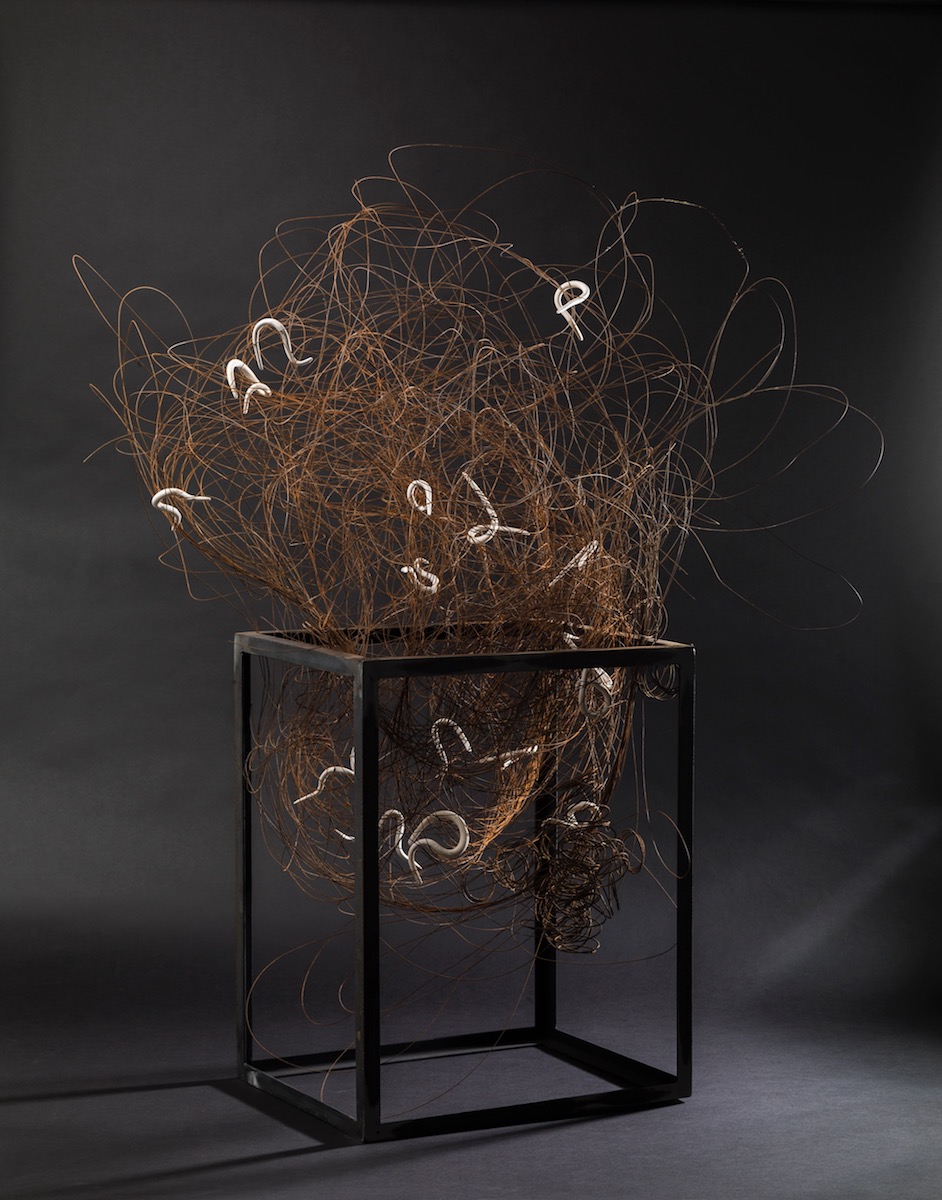
I was making steel boxes, large and small, which frame a bit of emptiness, for many years before the Covid hit us. When the world shut down I was left with different bags of clay, bits of wire and plenty of angle-section in my studio. After making lots of hanging pots from the clay for growing fruit and vegetables I started to explore sculpture.
I see these pieces as 3-d drawings: imagine the wire as thin pencil lines, the clay as white chalk and the steel frame as inky outlines. I am taking the pencil lines for walks, marking random places with soft white squiggles and this swirling wire cloud is held in a box with straight sides. I am trying to find my way through at this stage without an understanding of what is happening. I titled it: In the Grip of Something Big. It could also be: Setting the Cat Among the Pigeons. Something has happened that has got out of control. Subsequent pieces are getting calmer, the lines are beginning to follow patterns. Since then I have also been working with new clay shapes that remind me of flower forms although Nick says he sees them as prawn crackers. My garden has been a massive inspiration and joy these last four months and elements are creeping into the work. I am reassessing everything and I feel that this has now become necessary as big changes are happening all around us. I have always built models of my states of being and this seems to be the uncertainty phase, following on from the dark phase last autumn and winter.
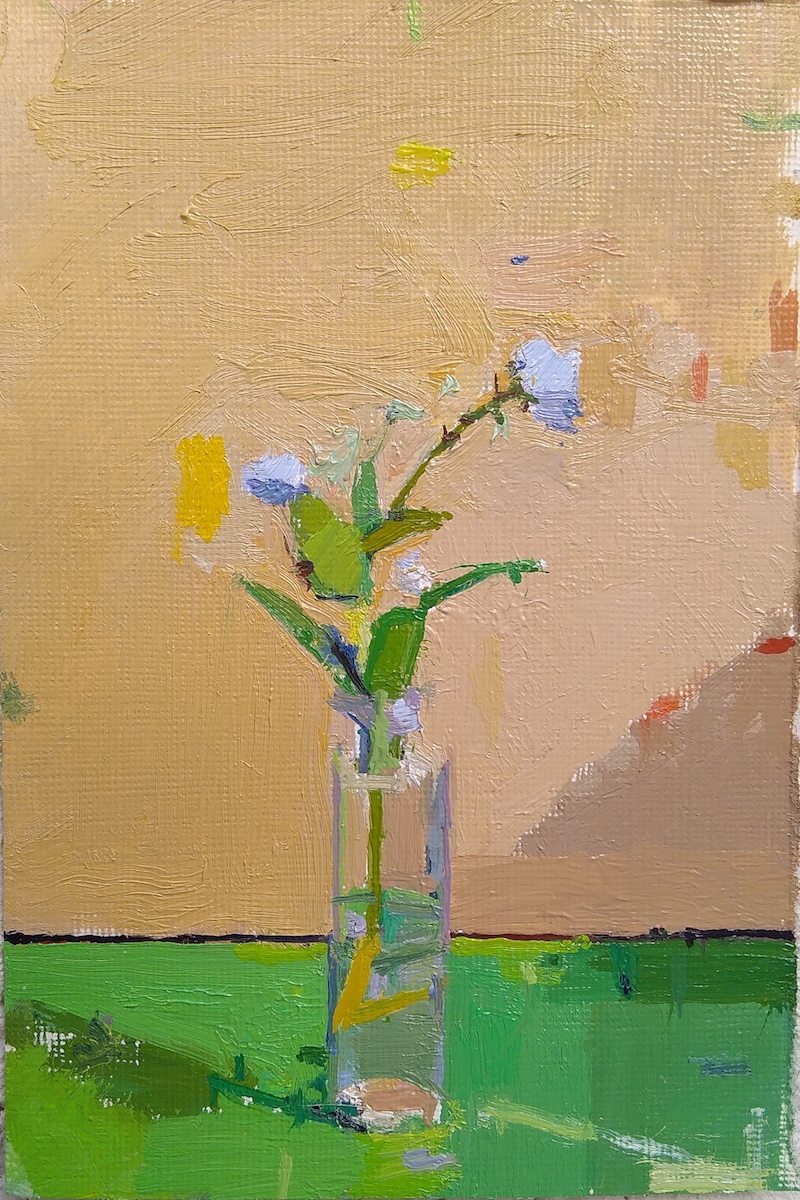
During this extreme and difficult time, adaptability has been crucial in everything. To improve my situation I added a long walk to my daily routine, before working, whether painting or teaching remotely.
Walking this Spring in Cornwall has been spectacular, there are so many ‘events’ to celebrate, demanding my attention, providing ideas and ‘things’ to work from and with, however, there is insufficient time.
The pandemic is challenging and disturbing, affecting my ability to work in the studio or in the landscape. I would not set out to respond to the pandemic directly but it will definitely be in there, somewhere.

I stopped working in my studio since the end of March until July, the longest I’ve ever been away I think, except for when my studio flooded in 2009. That changed my working methods too. This time though I got ill with COVID19 and was in bed for weeks. I started drawing my family in bed, then got really sick and could do nothing, then as I recovered I began creating little animations from felt figures I was making. I had started making these little figures pre lockdown in the studio (originally for comforting a friend with a broken heart) and brought back a shoe box of sewing things and felt. For weeks this shoe box was my studio. The animations were all made in this box, starting with one character (Fisherdottir) and making a world for her. Gradually I have been working both in another room in the house and outdoors. I do go to my studio now but want to finish this project. It suits the flexibility I need with other demands at home, being interrupted by family, and it’s easy to carry about.
My seventeen year old son Cole has been with me a lot, as he is off school, and he has been writing brilliant music for the animations, and is my most important critic.
I have loved the ability to focus, especially before I went back to teaching online. All I had to do was get well and make art. And I gave myself a theme to properly explore, and had delivery of a complex book about the psychoanalytic symbolism of The Holy Grail. I wouldn’t normally have had the time and ability to focus and read every word, often several times, which I did. And that was very special. I decided to embrace the outsider-ness of working from home. Not having the same aesthetics or production standards, but enjoying rapid amateur childish production as I did when a child. It brought back so many memories of when my bed was my world, of being ill, in hospital, and childhood toys and fabrics and fantasies.
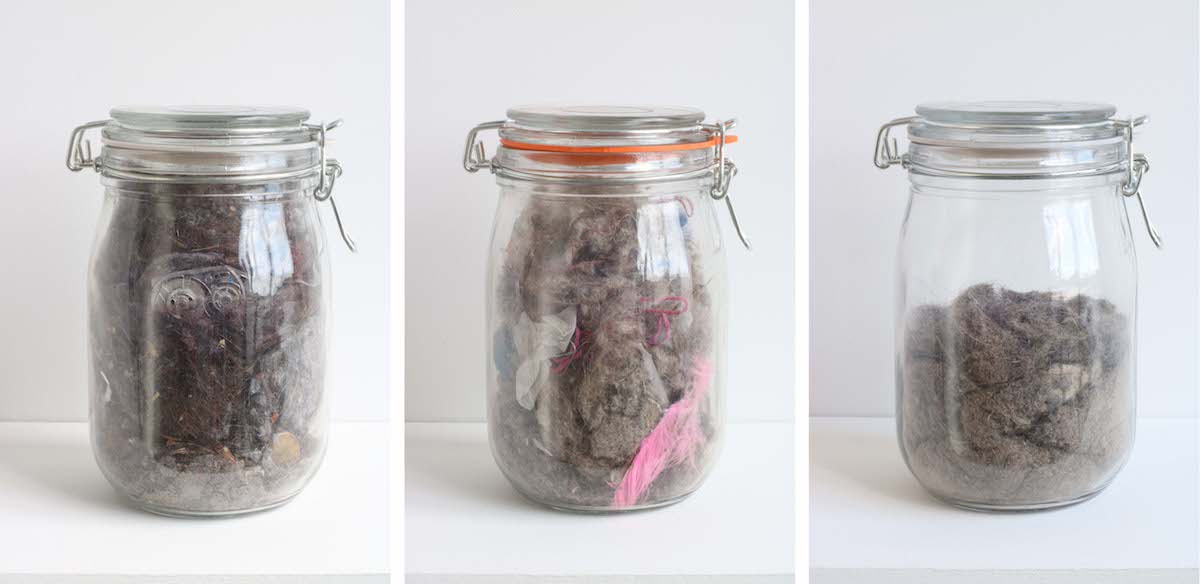
Lockdown began with the loss of a solo exhibition that I had been working towards for a long time. It took a while before I felt creative again, and when I did I felt compelled to physically document this unprecedented time.
I have been working with household dust for several years, exploring its intimate connection to the body (being largely made up of dead skin) and domestic lives.
When lockdown began to ease, and socially distanced conversations felt possible, I collected vacuum bags containing dust hoovered up during the lockdown period from forty households in my local community and began using this to create new works.
In the first of these works, I conserved the dust and debris retrieved from these ‘lockdown’ vacuum cleaner bags in a series of forty preserve jars to create a unique record of lockdown lives. Each jar contains physical traces of the inhabitants of one household. People and stories are entwined within the clumps of hair, dust and random objects – lego bricks, crafting remnants, sawdust and so on – reflecting the activities that were undertaken during lockdown within each home.
Lockdown … Experience and Influence.
…. Lockdown … isolation incarceration castration of movement and contact … monosyllabic time and space … variety straight jacketed … stimuli stunted … days nameless … monotony amplified … ‘the real’ strangulated and transformed …
… under Lockdown the only everyday live mediums and platforms left to a visual artist seemed to me to be virtual and time based … as all the other tangible media were rendered unapproachable and untouchable from the suspended direct experience of physical exhibition …
… (Marshall McLuhan’s title phrase, book and philosophy in 1964 … ‘The Medium is the Message’) …
… I took a Lockdown decision to reflect the ‘enforced living’ and use the Smart Phone as the most suitable ‘in the now’ tool for expressing ‘the moment’ in solidarity and introspection …
…not by way of change or the novel yet by looking for ‘the real’ in ‘the virtual’ in a time when our electronically projected recorded voice and the next to instant imagery of video becomes most primary …
… the most vital part of my practice is to find the right media and material/s at the right time to embody both concept and an impending integrity …
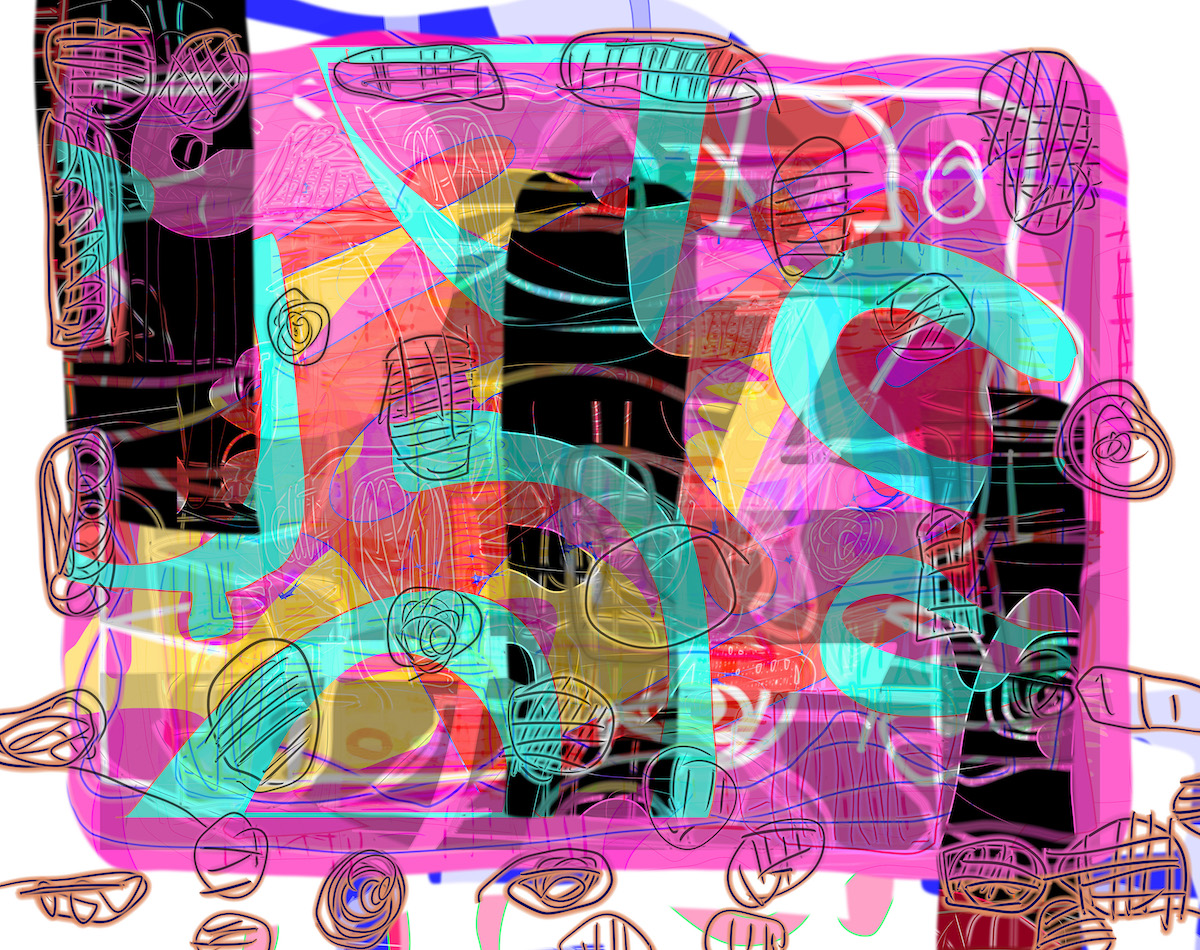
Lockdown meant adjusting to working away from my studio. As I work partly at home, using computers, this looked feasible. Thirty years ago I made a series called ‘Propositions’, digital prints improvised through an Amiga computer and a Xerox 4020 inkjet – primitive by today’s standards. Since then I have been integrating digital with regular painting. I looked back at that series and thought about what I could now conjure up, only hinted at back then – just sixteen colours, no soft edges, and the print resolution of knitting.
Well, after tentative beginnings, and a rule of making at least one picture a day, I found my theme: Vintage Wireless. A good source for titles. I have a nineteen-fifties Ferguson next to me, and have often thought of drawing it. Instead I read up about streamlined Bakelite boxes hiding valves and speaker. It has kept me going, with about 120 pictures done, and perhaps ten of these will make the cut. I wrote an essay, ‘Speed Limits: Digital Paint and Abstract Painting’, about all this, which is on the instantloveland painting site.
I have tried to use lockdown as a positive experience rather than a negative experience for my practice. I have been fortunate enough to stay in my studio so being creative and producing new ideas has not been a problem. I have used this change in time as a chance to reflect on works I was making before, and giving myself the opportunity to branch out by utilising new methods and techniques.
I researched into three artists who enabled me to heighten my knowledge within my making. These artists were; Peter Sedgley, Fahrelnissa Zeid and Helen Frankenthaler.
As I mentioned I did not want ‘lockdown’ to become a frustrating and challenging time. Instead I took effect from Frankenthaler’s approach to producing, and used it as time to try out new possibilities.
I created a new body of work throughout the month of May titled; MAY 2020 – STUDY SERIES.
One of the main subjects I focused on was the Principles of Colour. One of the main themes I wanted to test out was the Contrasting of Colours, how the analogue of different colours can draw our attention further to an image.
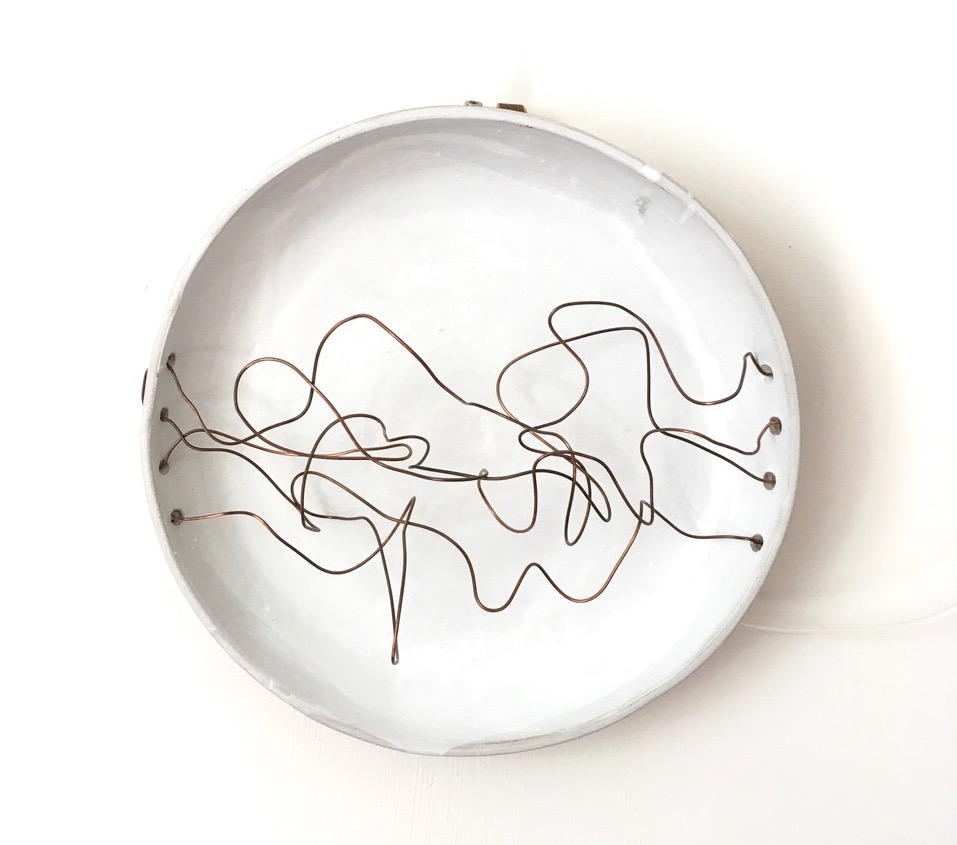
Lockdown – The gift of a studio and time to use it
At the beginning of February I was ‘between studios’ and paying hourly for a space in a pottery down the road. At the beginning of March I had been offered a desk there, a space to work. Talk about timing…
In response to general stresses and strains I make clay objects and attach copper, thinking about silicon chips and circuitry in communications. The lockdown increased some stresses but obviously stopped lots of others.
I lasted a month in the house before I escaped the teenagers for the solitude of the studio. I started making practical things and piercing lots of holes in them. I noticed the sudden lack of shows to prepare for freed up my making.
Working with clay is grounding, methodical, and very therapeutic. I find the plasticity of it combined with copper very pleasing.
There is lots to explore, lots of abstract objects, and bigger holes to be made in any that risk being too practical.
The quiet creativity of this time has given me structure and definitely enabled my positive mental health. This in turn allowed me to support friends and family with love.
Onwards.

I made this 28 ft x 8 ft charcoal drawing. It’s called ‘Others’, a reference to the fear of the unknown experienced by an immigrant washed up on a foreign shore. It took on a more menacing look as I was making it, I’m sure because of the world-wide threat of the virus. In fact I found it quite scary every time I worked on it.
I HAVENT BEEN TO MY STUDIO SINCE APRIL,
THIS IS A COMPLETELY NEGATIVE EXPERIENCE
THERE IS NO MOTIVATION WHATSOEVER ,
IN VISUAL TERMS THERE IS NOTHING TO DEPICT
THE ART SCENE REFLECTS THE BOLLOCKS SITUATION
AS SOCIAL COMMENT CAN ONLY BE NEGATIVE TOWARDS ESTABLISHMENTS
RESULT IS GREED SOCIAL INJUSTICE PARANOIA AND TRIUMPH OF MONEY AGAIN
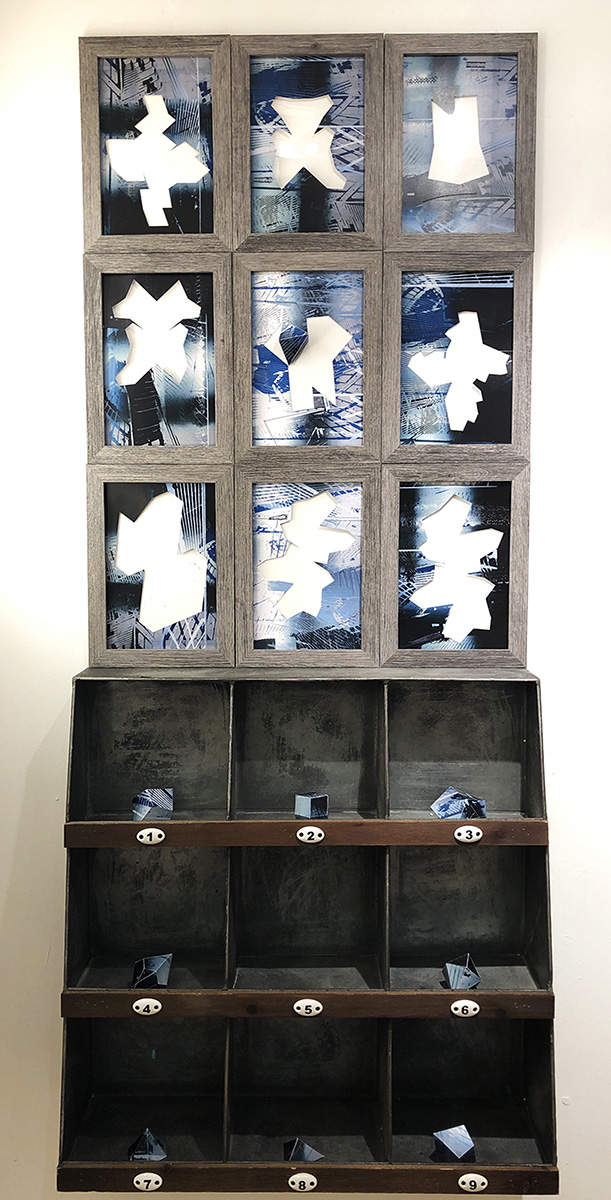
Most exhibitions were made more accessible to a wider/universal audience & lasted for longer & permitted larger installations, than had the physical exhibition taken place.
Took part in many postcard projects – the 1st : WORLD BOOK NIGHT at UWE Bristol. Little did we know how ironic our decision not to travel would be. Next I designed A Graphic Score for the POSTCARD PIECES CONCERT of the London Sinfonietta: Lies, Damned Lies & Statistics [apologies to Twain & Disraeli] based on the daily Coronavirus Update Statistics. Another selection of 9 postcards from the Feeling the Blues series was offered on my instagram account for FREE barter/exchange for a voluntary donation/any fee/to anyone for the ONE OF MANY PROJECT. 2 major exhibitions scheduled for the Royal Academy: the LONDON ORIGINAL PRINT FAIR (which should have only run for 3 days in May) ran on for a month & has now reopened as lockdown eased last week. The shortlisted work for the RA SUMMER EXHIBITION is back on track with the opening scheduled for 6th October 2020. Two works were exhibited at the Megaloprint Studio 40th ANNIVERSARY EXHIBITION in Canberra Australia – the RELIEF exhibition & SCREEN ON PAPER current exhibition.

Lockdown has changed my practice. No more city life to bring ideas to mind, no more models in situ. So a collapsing of subject and work practice to embrace and reflect the micro life we are all now living in. This does not mean that the macro concerns are not embedded within this.
So, mining my inner life. Exploring myth to examine politics and behaviour: a return to themes explored before. More work from drawings and memory to bring people to me and my studio Using what I have to hand in all senses including paint, paper and canvas.
My routine has changed too.
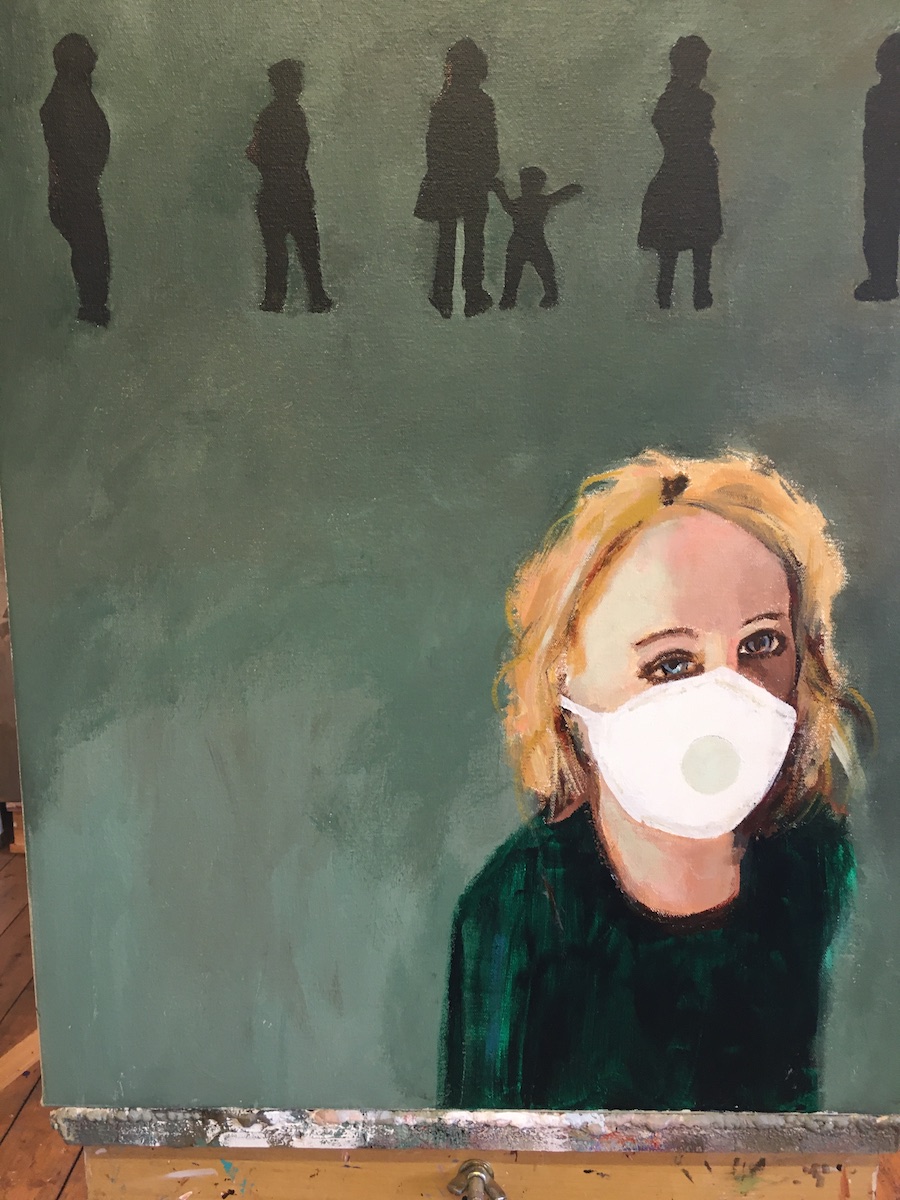
On 13th February 2020 I had a cardiac arrest at home. My heart just stopped beating. An emergency ambulance was called and I was whisked to the Royal Free Hospital in Hampstead. I was put into an induced coma for three days and was on a ventilator and spent nearly four weeks in the hospital during the start of the coronavirus pandemic. My family was warned that I might not survive. I am lucky to be alive and well. This and the lockdown have influenced the way I work but not radically. I have always produced art which mirrors what is happening to me and in the world; work which can be disturbing but hopefully is sometimes beautiful and what people can relate to.
During lockdown I have produced a lot of paintings and one lightbox work. Some of these works strongly relate to covid- 19 virus, particularly “Herd Immunity”, “Seven Seconds Away” and “Breathless”.
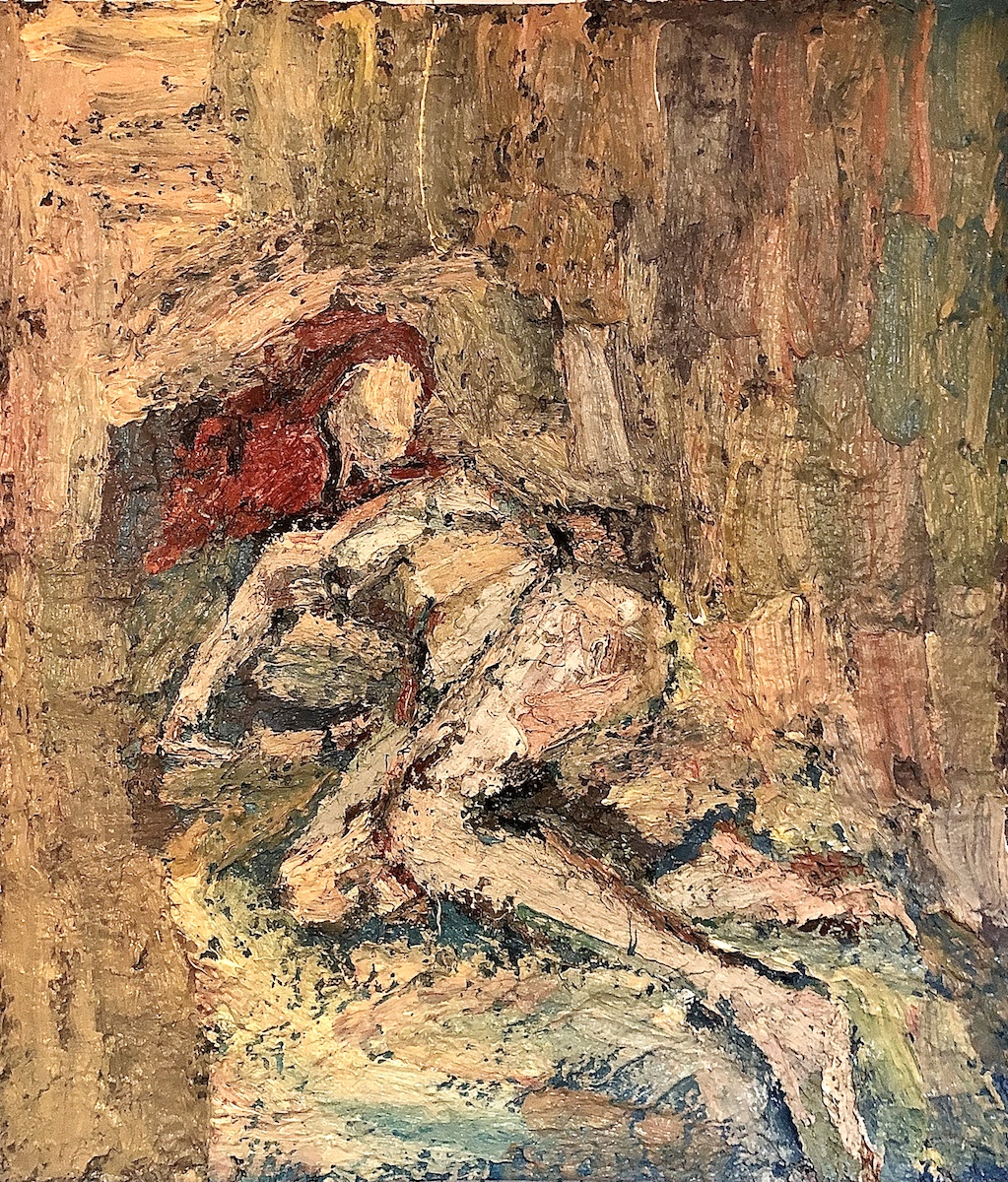
Lockdown, what it reminds me of most is the helplessness of being out of control, which made me think of a previous time, leaving the protective environment of Art School. Out in the open where nobody knows you or is looking at what you do. The existential freedom of discovering who you are and the motivational drive mixed with hope.
I have my studio attached to the house with a plentiful supply of previously ordered oil paint. Opportunities presented themselves, daughter and grandson staying with us while her husband self isolated, a rare circumstance to paint subject matter close to the heart. I was having the time to scroll through 40 years of sketchbooks, past reminders, culling the plan chests of unwanted drawings, reassessing older paintings and repainting them. Experimentation, potboilers, following a developing pattern of thought, letting the work lead.
Motivation, waxing and waning, believing in social media clicks, creativity probably never to be seen. Far away from the merry-go-round of the market place, the only reasoning to keep going on and stay safe.
Mind games under lockdown, an article about Peter Clossick by Corinna Lotz, is published through the Real Democracy Movement.
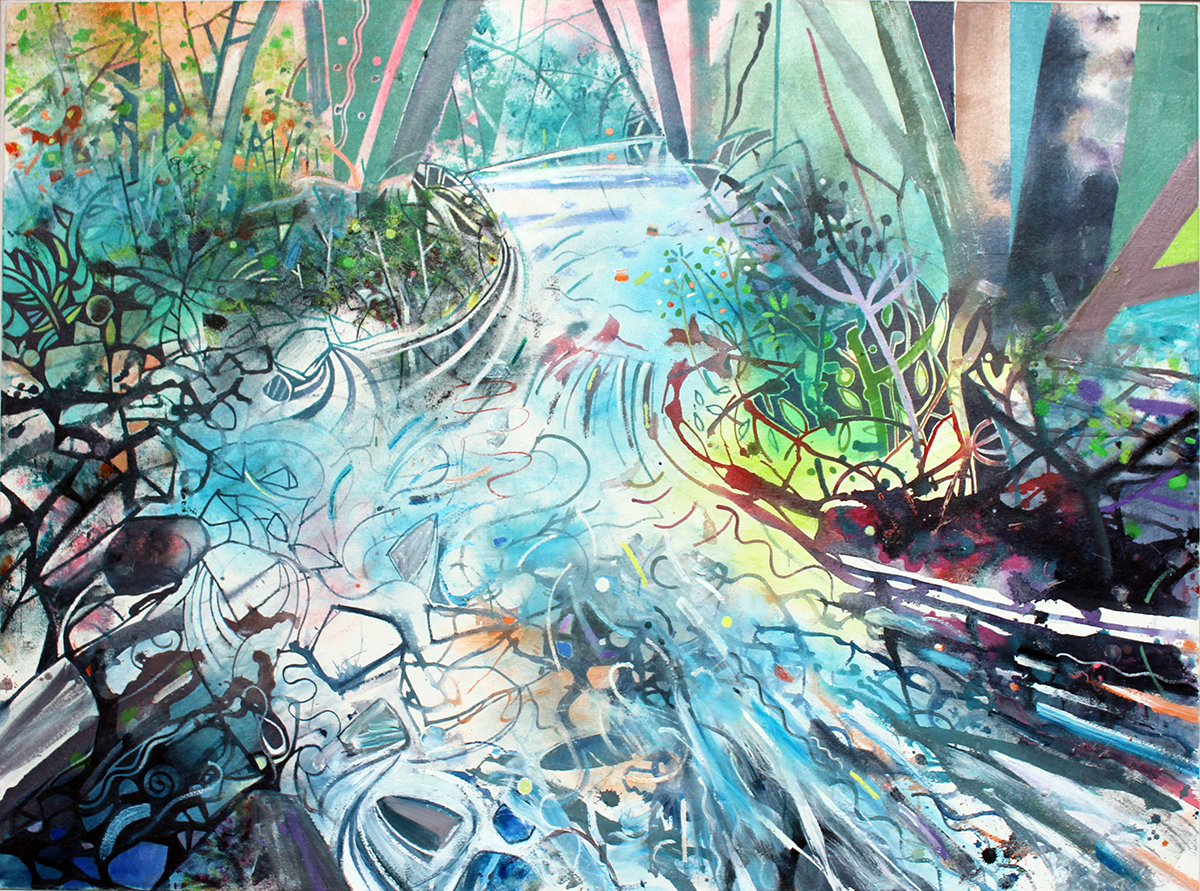
The worse part of virus isolation has been missing family, friends and students. But in relation to my art in many ways things haven’t been very different as I am lucky enough to have my studio at the end of the garden. Indeed I have had more time to work with no teaching (which I miss) and visits etc. But I have noticed a different emphasis in my subject matter which has turned much more to celebrating the wilder places such as the Devon coast and Dartmoor rivers. A hankering after these places whilst isolated in suburbia seems to have been taking place. I was due to teach a painting course on Dartmoor which was cancelled and I have made a series of paintings based on a beautiful Dartmoor river. Likewise unable to go on our normally frequent visits to the coast I have made several paintings inspired by a part of the Devon coast that I have loved and visited frequently for many years.
Another project occupying my time has been an essay for a book , that sadly didn’t happen but took me to research examples of art flourishing in the face of manmade and natural disasters. From the Arpilleras defying Pinochet to great artists such as Titian and Giorgione producing some of history’s greatest paintings under the constant threat of death by the 300 year reign of the Black Death.
Art will shine like a beacon in times of war, human cruelty and pestilence.


